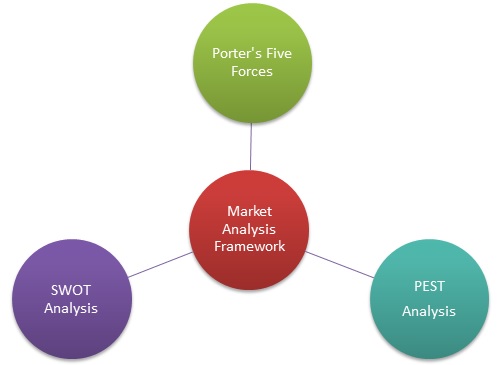- Business Concepts ›
- Marketing and Strategy ›
- Market Analysis Framework
Market Analysis Framework
Definition & Importance
This article covers meaning & overview of Market Analysis Framework from marketing perspective.
What is meant by Market Analysis Framework?
Market Analysis Framework is a tool which is used by the companies and entrepreneurs to study the market for its products or services. By using market analysis frameworks in detail, companies get to understand the competitive dynamics of the market in terms of demand and supply of the products and services, external factors of the industry, state of competition and degree of competition within industry, the future aspects of the industry and difference between their organization and the competitors.
Importance of Market Analysis Frameworks
No matter how great the idea or the product is, every product has a market or a set of markets for it which needs to be identified. Then only, the company or the brand can see its full potential. Launching the product or the brand in a wrong market may prove detrimental to the brand and the company. Thus, Market analysis framework is a method for companies and entrepreneurs to understand their position in the market with respect to other competitors. By studying the market in detail using market analysis frameworks, they get an idea of the untapped opportunities that they can embark upon. It helps entrepreneurs to calculate the return that they can get by investing in the particular market, calculate the costs associated with entering and exiting the market, to identify in which stage the market is currently and where it tends to go in near future, to determine whether the market is growing or has reached its saturation point etc.

Market Analysis Frameworks Tools
There are three most important and commonly used market analysis frameworks:
1. Porter Five Forces Model
2. SWOT analysis
3. PEST & PESTLE analysis
These models help companies analyse their competition & improve their strategy.
They are described as follows-
1. Porter five forces model
Market Analysis Framework by Porters is the Competitive forces model, which comprises of 5 factors that are-
a) Existing competitive rivalry between suppliers
b) Threat of new market entrants
c) Bargaining power of buyers
d) Bargaining Power of suppliers
e) Threat of substitute products (including technology change)
2. SWOT Analysis
SWOT analysis is the strategic mapping tool under market analysis frameworks which assesses an organization and the industry in which it operates. It stands for Strengths, Weaknesses, Threats and Opportunities. Here, Strengths and Weaknesses are the internal factors to an organization whereas Opportunities and threats are external factors to the organization. SWOT model is particularly useful in deciding whether or not to embark on a particular project by analyzing its positives and negatives and how to look forward.
3. PEST Analysis
PEST Analysis, also known as Broad Factors analysis is very important market analysis framework, useful for analyzing the external environment to an organization. PEST analysis stands for Political, Economic, Social and Technological. With legal & environmental factors, ir is known as PESTLE analysis. Political factors include specific rules and regulations with respect to political environment of the business like Ease of doing business, political stability, labor laws, trade policies and political stability. Economic factors include GDP growth rate, inflation rate, exchange rate, capital markets etc. Social factors include factors that are related to the society and the people belonging to it. It includes health, fashion trends, demographics, age group, gender ratio. Technological factors include advancements and recent developments in the technological environment.
Hence, this concludes the definition of Market Analysis Framework along with its overview.
This article has been researched & authored by the Business Concepts Team which comprises of MBA students, management professionals, and industry experts. It has been reviewed & published by the MBA Skool Team. The content on MBA Skool has been created for educational & academic purpose only.
Browse the definition and meaning of more similar terms. The Management Dictionary covers over 1800 business concepts from 5 categories.
Continue Reading:
What is MBA Skool?About Us
MBA Skool is a Knowledge Resource for Management Students, Aspirants & Professionals.
Business Courses
Quizzes & Skills
Quizzes test your expertise in business and Skill tests evaluate your management traits
Related Content
All Business Sections
Write for Us